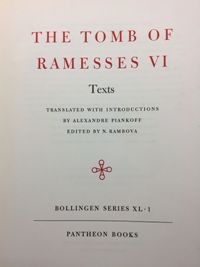
Ramesses VI Nebmaatre-Meryamun (sometimes written Ramses or Rameses, also known under his princely name of Amenherkhepshef was the fifth pharaoh of the Twentieth Dynasty of Egypt. He reigned for about eight years in the mid-to-late 12th century BC and was a son of Ramesses III and queen Iset Ta-Hemdjert. As a prince, he was known as Ramesses Amunherkhepeshef and held the titles of royal scribe and cavalry general. He was succeeded by his son, Ramesses VII Itamun, whom he had fathered with queen Nubkhesbed.
After the death of the ruling pharaoh, Ramesses V, who was the son of Ramesses VI's older brother, Ramesses IV, Ramesses VI ascended the throne.
Ramesses VI was buried in the Valley of the Kings, in a tomb now known as KV9.The tomb was first built for Ramesses V, who may have been buried in it for the short period of time necessary for another, likely undecorated tomb, to be cut for him somewhere else in the Valley of Kings and which remains to be discovered. In any case, Ramesses VI commanded that KV9 be entirely refurbished for himself with no space left for Ramesses V's permanent burial, who was finally led to rest in Ramesses VI's second year on the throne.
The renewed works on KV9 are responsible for the preservation of that of Tutankhamun, the entrance of which was buried beneath huts built for the craftsmen working on Ramesses VI's tomb.
Тhe tomb was finally ready for the king in his eighth year on the throne, at which point he might have been ill and nearing death. Once finished, the tomb was 104 m (341 ft)-long and included one of only three complete renditions of the Book of Gates known from royal funerary context, as well as a complete version of the Book of Caverns.
The entrance is decorated with a disk containing a scarab and an image of the ram-headed Ra between Isis and Nephthys who are kneeling. The jambs and thicknesses, mentions the name of Ramesses VI. The jambs are usurped from Ramesses V.
On both sides are images of Ramesses VI before Ra-Harakhti and Osiris. The scenes originally depicted Ramesses V but were usurped. On the south wall of the corridor are scenes from the Book of Gates, while the North wall is decorated with scenes from the Book of Caverns.
The corridor ends in a hall that is decorated with an intricate astronomical ceiling. On the left (south) wall the Book of Gates is continued. The decorations show divisions 10 and 11 including Nun holding up the bark of Ra with Nut above the scene. On the right side of the hall (the north) the Book of Caverns scenes continue. Above the entrance to the next corridor the king is shown censing and libating before Osiris. Ramesses Vi is shown is a variety of scenes before gods and goddesses such as Meretseger, Khonsu, Ptah and Ptah-Sokar-Osiris.
In the descent to the second corridor the decorations show scenes from the Book of the Imi-Duat. The ceiling depicts the barks of Ra and the Books of the Day and Night. Ramesses VI is shown before Hekau, and Maat.
The last hall contains scenes from the Book of the Dead and the Book of Aker.
Within 20 years of Ramesses VI's burial, the tomb was most probably desecrated and ransacked by grave robbers, who hacked away at the hands and feet of Ramesses' mummy to gain access to his jewelry. These events, occurring during the reign of Ramesses XI,[are described in the Papyrus Mayer B although the identification of the tomb mentioned in this source is not entirely certain. Ramesses VI's mummy was subsequently moved to the tomb KV35 of Amenhotep II during the reign of Pinedjem of the early Twenty-First Dynasty, where it was discovered in 1898 by Victor Loret. A medical examination of the mummy revealed that Ramesses VI died aged around forty, and showed severe damage to his body, the head and torso being broken into several pieces by an axe used by the tomb robbers.
In the Graeco-Roman period, the tomb was identified as that of Memnon, the mythological king of the Ethiopians who fought in the Trojan War. As a result, it was frequently visited; 995 graffiti left by visitors have been found in the tomb, ranging from the 1st century BC to the 4th century AD.
This edition contains both the texts and image reproductions from this monument and is a result of the special expedition from October 1949 to June 1951, sponsored by Bollingen Foundation.
The author is Alexandre Piankoff (1897-1966), well-known egyptologist from Russian descent.

